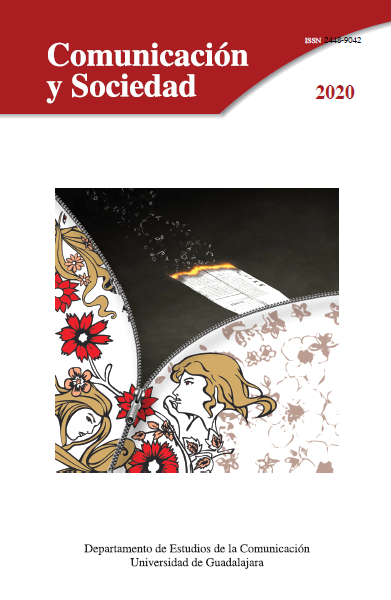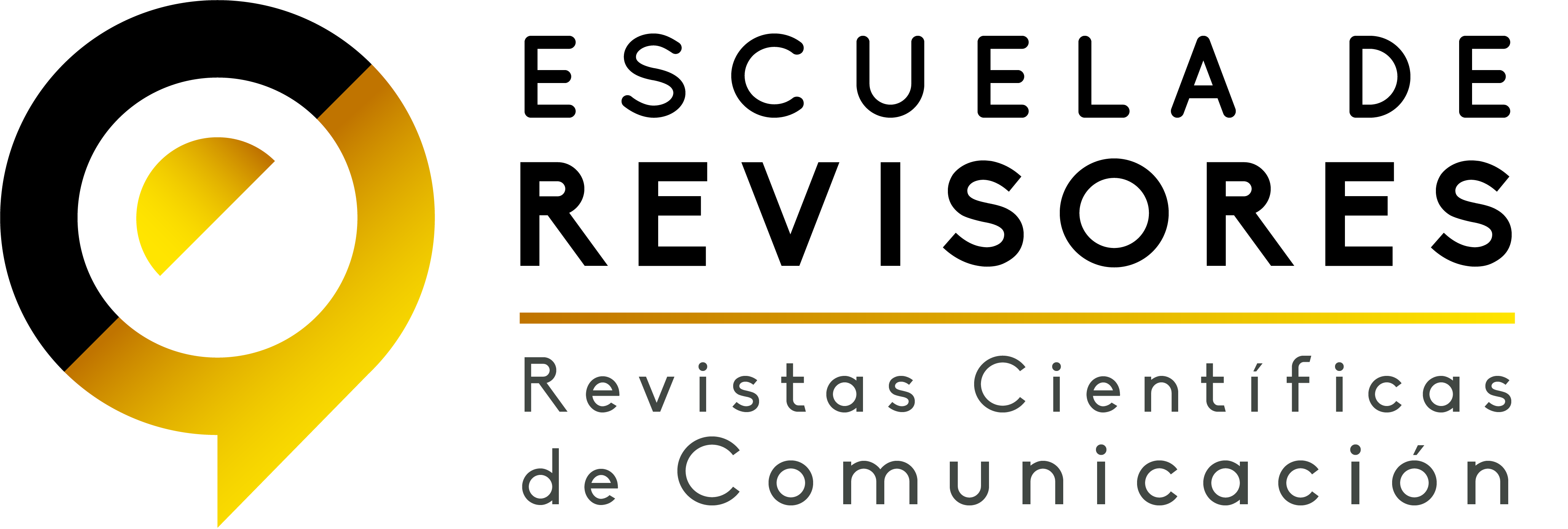Factores antecedentes de los encuadres de juego estratégico y temático en la cobertura de campañas electorales locales en el contexto mexicano
DOI:
https://doi.org/10.32870/cys.v2020.7643Palabras clave:
Teoría del framing, Campañas políticas, Comunicación política, EncuadresResumen
La investigación sobre qué factores en la cobertura de los medios están asociados con los encuadres temático y de juego estratégico puede ayudar a comprender las causas de la proliferación de ambos encuadres periodísticos. En este artículo se analizó la cobertura de radio y televisión de las campañas electorales de 2018 en el estado de Jalisco (México). Nuestros hallazgos muestran una mayor presencia del encuadre temático en comparación con el encuadre de juego estratégico, y confirman que el tipo de concesión y sector de la organización de medios, el tipo de elección, el género de la candidatura y variables temporales-contextuales predicen el uso de ambos encuadres periodísticos de forma significativa.Descargas
Citas
Aalberg, T., Strömbäck, J. & De Vreese, C. H. (2012). The framing of politics as strategy and game: A review of concepts, operationalizations and key findings. Journalism, 13(2), 162-178. https://doi.org/10.1177%2F1464884911427799
Baños, M. A. (24 de junio de 2018). Futbol y elecciones. El Economista. https://www.eleconomista.com.mx/opinion/Futbol-y-elecciones-20180624-0075.html
Cappella, J. N. & Jamieson, K. H. (1997). Spiral of cynicism: The press and the public good. Oxford University Press on Demand.
Dan, V. & Iorgoveanu, A. (2013). Still on the beaten path: How gender impacted the coverage of male and female Romanian candidates for European Office. The International Journal of Press/Politics, 18(2), 208-233. https://doi.org/10.1177%2F1940161212473508
Dekavalla, M. (2016). Issue and game frames in the news: Frame-building factors in television coverage of the 2014 Scottish independence referendum. Journalism, 19(11), 1508-1607. https://doi.org/10.1177%2F1464884916674231
De Vreese, C. H. & Elenbaas, M. (2008). Media in the game of politics: Effects of strategic metacoverage on political cynicism. The International Journal of Press/Politics, 13(3), 285-309. https://doi.org/10.1177%2F1940161208319650
Dimitrova, D. V. & Kostadinova, P. (2013). Identifying antecedents of the strategic game frame: A longitudinal analysis. Journalism & Mass Communication Quarterly, 90(1), 75-88. https://doi.org/10.1177%2F1077699012468739
Dimitrova, D. V. & Strömbäck, J. (2012). Election news in Sweden and the United States: A comparative study of sources and media frames. Journalism, 13(5), 604-619. https://doi.org/10.1177%2F1464884911431546
Dunaway, J. & Lawrence, R. G. (2015). What predicts the game frame? Media ownership, electoral context, and campaign news. Political Communication, 32(1), 43-60. https://doi.org/10.1080/10584609.2014.880975
Echeverría Victoria, M. (2018). Comercialismo periodístico y cobertura estratégica de las elecciones. Modelo teórico metodológico para explorar su relación. Estudios sobre el Mensaje Periodístico, 24, 155-172. https://doi.org/10.5209/ESMP.59943
Echeverría, M. & González, R. A. (2018). Media logic and journalistic commercialism. A longitudinal analysis of frames in campaign coverage. Communication & Society, 31(1). https://revistas.unav.edu/index.php/communication-and-society/article/view/35723
Entman, R. M. (1993). Framing: Toward clarification of a fractured paradigm. Journal of Communication, 43(4), 51-58. https://doi.org/10.1111/j.1460-2466.1993.tb01304.x
Graber, D. (2003). The media and democracy: Beyond myths and stereotypes. Annual Review of Political Science, 6(1), 139-160. https://doi.org/10.1146/annurev.polisci.6.121901.085707
Habermas, J. (1974). The public sphere: An encyclopedia article. 1964. New German Critique, 3, 49-55. https://doi.org/10.2307/487737
Instituto Federal de Telecomunicaciones-IFT. (2016). Encuesta nacional de consumo de contenidos audiovisuales 2016. http://www.ift.org.mx/
Jackson, D. (2011). Strategic news frames and public policy debates: Press and television news coverage of the euro in the UK. Communications, 36, 169-193. https://doi.org/10.1515/comm.2011.009
Kahn, K. F. (1994). The distorted mirror: Press coverage of women candidates for statewide office. The Journal of Politics, 56(1), 154-173. https://doi.org/10.2307/2132350
Kim, S. H., Carvalho, J. P. & Davis, A. C. (2010). Talking about poverty: News framing of who is responsible for causing and fixing the problem. Journalism & Mass Communication Quarterly, 87(3-4), 563-581. https://doi.org/10.1177%2F107769901008700308
Lau, R. R. & Rovner, I. B. (2009). Negative campaigning. Annual Review of Political Science, 12, 285-306. https://doi.org/10.1146/annurev.polisci.10.071905.101448
Lawrence, R. G. (2000). Game-framing the issues: Tracking the strategy frame in public policy news. Political Communication, 17(2), 93-114. https://doi.org/10.1080/105846000198422
Lippmann, W. (1922). Public Opinion. Project Gutenberg.
Lombard, M., Snyder-Duch, J. & Bracken, C. C. (2004). Practical resources for assessing and reporting intercoder reliability in content analysis research projects. https://www.academia.edu/5958582/Practical_Resources_for_Assessing_and_Reporting_Intercoder_Reliability_in_Content_Analysis_Research_Projects
Lühiste, M. & Banducci, S. (2016). Invisible women? Comparing candidates’ news coverage in Europe. Politics & Gender, 12(2), 223-253. https://doi.org/10.1017/S1743923X16000106
McDonald, J. H. (2014). Handbook of Biological Statistics [3rd Ed.]. Sparky House Publishing.
Muñiz, C. (2015). La política como debate temático o estratégico. Framing de la campaña electoral mexicana de 2012 en la prensa digital. Comunicación y Sociedad, 23, 67-95. https://doi.org/10.32870/cys.v0i23.64
Rafter, K., Flynn, R., Mcmenamin, I. & O’Malley, E. (2014). Does commercial orientation matter for policy-game framing? A content analysis of television and radio news programmes on public and private stations. European Journal of Communication, 29(4), 433-448. https://doi.org/10.1177%2F0267323114532204
Rhee, J. W. (1997). Strategy and issue frames in election campaign coverage: A social cognitive account of framing effects. Journal of Communication, 47(3), 26-48. https://doi.org/10.1111/j.1460-2466.1997.tb02715.x
Rodelo, F. V. (2016). Gender disparities in the media coverage of local electoral campaigns in Mexico. Cuadernos.info, 39, 87-99. https://doi.org/10.7764/cdi.39.965
Rodelo, F. V. (2019). After parity. A mixed methods study on gender bias in the volume of media coverage of electoral campaigns. Revista de Comunicación Política, 1(1), 67-86. https://doi.org/10.29105/rcp1-4
Rodelo, F. V. & Muñiz, C. (2016). Uso del análisis de conglomerados para la detección de encuadres noticiosos en el tratamiento periodístico de la Iniciativa Mérida. Comunicación y Sociedad, 27, 53-77. https://doi.org/10.32870/cys.v0i27.4792
Schmuck, D., Heiss, R., Matthes, J., Engesser, S. & Esser, F. (2016). Antecedents of strategic game framing in political news coverage. Journalism, 18(8), 937-955. https://doi.org/10.1177%2F1464884916648098
Schuck, A. R., Boomgaarden, H. G. & De Vreese, C. H. (2013). Cynics all around? The impact of election news on political cynicism in comparative perspective. Journal of Communication, 63(2), 287-311. https://doi.org/10.1111/jcom.12023
Schuck, A. R., Vliegenthart, R., Boomgaarden, H. G., Elenbaas, M., Azrout, R., Van Spanje, J. & De Vreese, C. H. (2013). Explaining campaign news coverage: How medium, time, and context explain variation in the media framing of the 2009 European parliamentary elections. Journal of Political Marketing, 12(1), 8-28. https://doi.org/10.1080/15377857.2013.752192
Secretaría de Gobernación. (2013). Resultados de la Quinta Encuesta Nacional sobre Cultura Política y Prácticas Ciudadanas ENCUP 2012. http://encup.gob.mx/
Shoemaker, P. J. & Reese, S. D. (2014). Mediating the message in the 21st century: A media sociological perspective. Routledge.
Snow, D. A., Vliegenthart, R. & Corrigall-Brown, C. (2007). Framing the French riots: A comparative study of frame variation. Social Forces, 86(2), 385-415. https://doi.org/10.1093/sf/86.2.385
Strömbäck, J. (2016). Does public service TV and the intensity of the political information environment matter? Journalism Studies, 18(11), 1415-1432. https://doi.org/10.1080/1461670X.2015.1133253
Strömbäck, J. & Dimitrova, D. V. (2011). Mediatization and media interventionism: A comparative analysis of Sweden and the United States. The International Journal of Press/Politics, 16(1), 30-49. https://doi.org/10.1177%2F1940161210379504
Strömbäck, J. & Van Aelst, P. (2010). Exploring some antecedents of the media’s framing of election news: A comparison of Swedish and Belgian election news. The International Journal of Press/Politics, 15(1), 41-59. https://doi.org/10.1177%2F1940161209351004
Valenzuela, S. & Correa, T. (2009). Press coverage and public opinion on women candidates: The case of Chile's Michelle Bachelet. International Communication Gazette, 71(3), 203-223. https://doi.org/10.1177%2F1748048508100913
Vidal-Correa, F. (2020). Media coverage of campaigns: A multilevel study of Mexican women running for office. Communication & Society, 33(3), 167-186. https://doi.org/10.15581/003.33.3.167-186
Vliegenthart, R., Boomgaarden, H. G., Van Aelst, P. & De Vreese, C. H. (2010). Covering the US presidential election in Western Europe: A cross-national comparison. Acta Politica, 45(4), 444-467. https://doi.org/10.1057/ap.2010.2
Zeh, R. & Hopmann, D. N. (2013). Indicating mediatization? Two decades of election campaign television coverage. European Journal of Communication, 28(3), 225-240. https://doi.org/10.1177%2F0267323113475409
Descargas
Publicado
Cómo citar
Número
Sección
Licencia
Derechos de autor 2020 Frida V. Rodelo

Esta obra está bajo una licencia internacional Creative Commons Atribución-NoComercial 4.0.
Los autores/as que publiquen en esta revista aceptan las siguientes condiciones:
De acuerdo con la legislación de derechos de autor, los autores conservan los derechos de autoría y otorgan a Comunicación y Sociedad el derecho de primera comunicación pública de la obra. Comunicación y Sociedad no realiza cargos a los autores por enviar y procesar artículos para su publicación.
Los autores/as pueden realizar otros acuerdos contractuales independientes y adicionales para la distribución no exclusiva de la versión del artículo publicado en Comunicación y Sociedad (por ejemplo incluirlo en un repositorio institucional o publicarlo en un libro) siempre que indiquen claramente que el trabajo se publicó por primera vez en Comunicación y Sociedad.


























